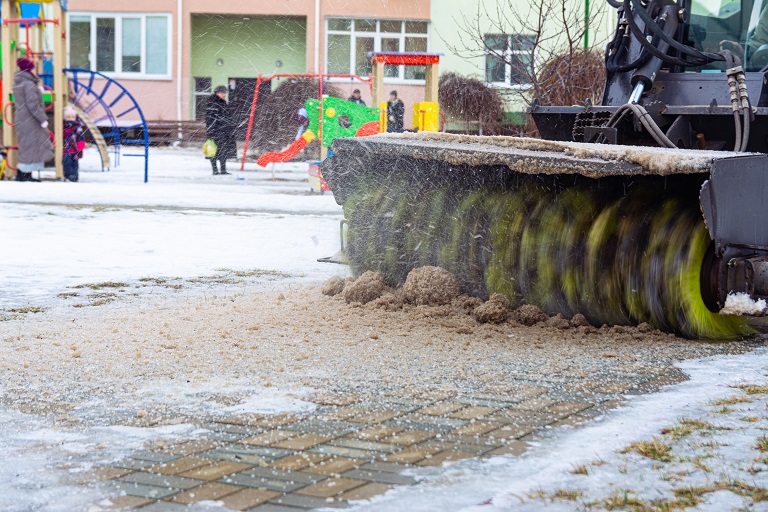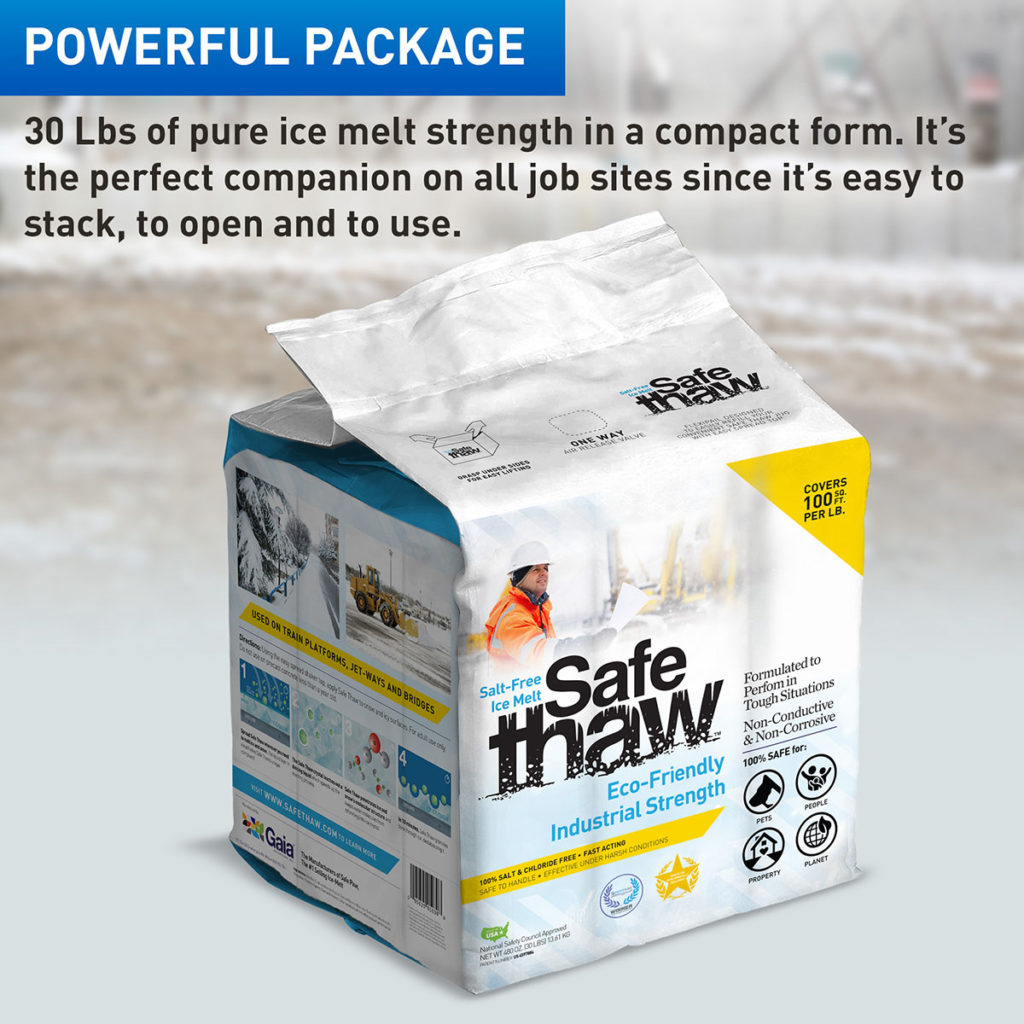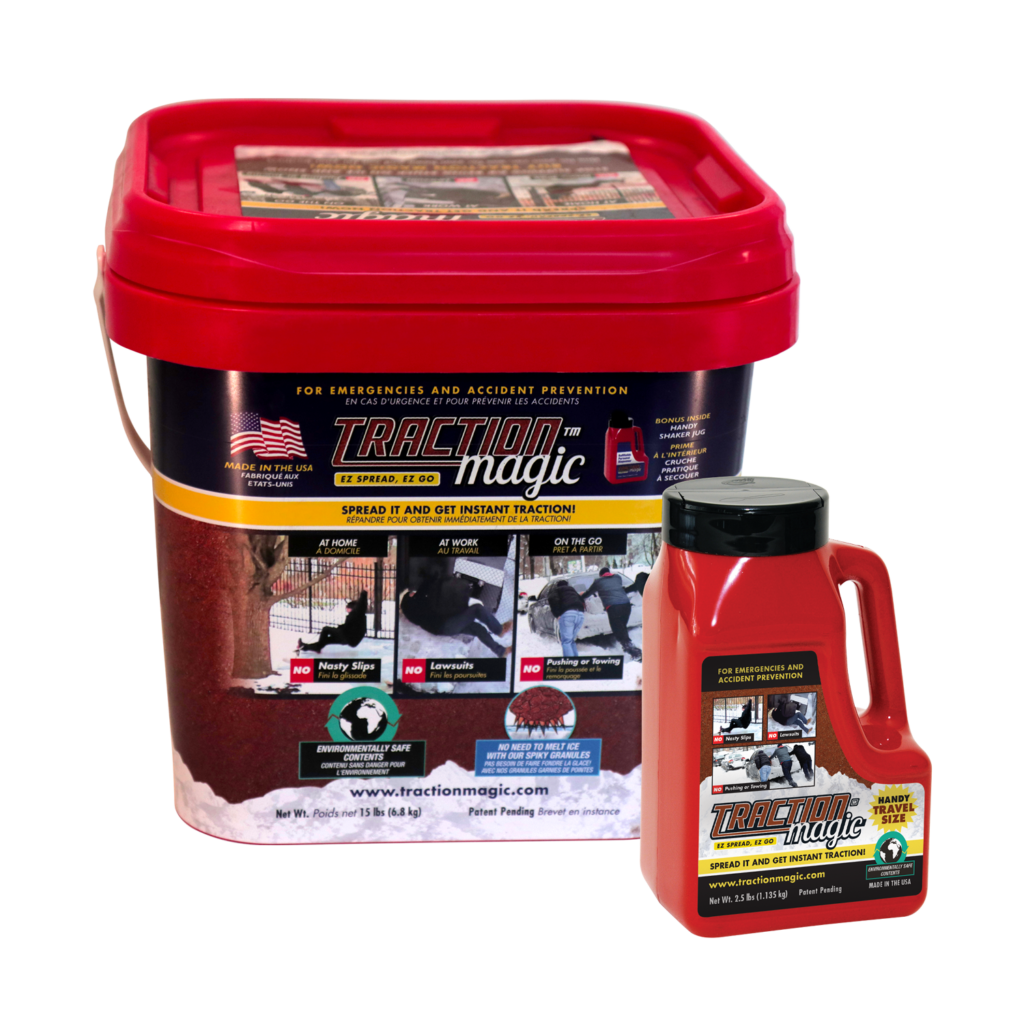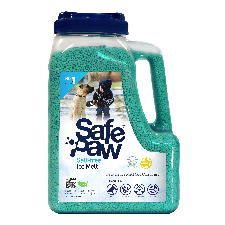What Ice Melt You Can Use On A Newly Laid Concrete Driveway

Concrete is one of the most durable materials. It’s used in everything from sidewalks to driveways and is a popular choice for homeowners who want a low-maintenance flooring option that will last for years or even decades. This article will give you all the information you need about using deicer products on freshly poured cement surfaces. We will also discuss the best way to melt ice on concrete driveway.
Ice Melt Damage Concrete
Ice melt, when used incorrectly or in excess, can potentially damage concrete. The primary concern is that many traditional ice melt products contain sodium chloride (rock salt) or calcium chloride, which can be corrosive to concrete surfaces. These chemicals may cause scaling, pitting, or other forms of deterioration over time, especially on newly poured concrete.

To Avoid Use of Sodium Chloride or Calcium Chloride
Carefully read the labels of any ice melters you are considering purchasing. Avoid the use of sodium chloride or calcium chloride on your new concrete driveway, as these chemicals can put you at risk for surface spalling and other aesthetic issues. Sodium chloride is typically used in deicing products because it’s cheap and effective, but it can cause corrosion to metal surfaces, like siding or gutters. It’s also known to cause pitting and efflorescence (a white powdery coating that looks like salt on top of your concrete).
Calcium chloride is another common chemical in rock salt brands that can cause concrete damage. If its crystals get inside cracks in the pavement before they harden or become sealed with overlays, they may later expand when exposed to moisture.
To Avoid Applying Ice Melt To Any Concrete Until it’s Cured
Concrete takes 28 days to cure but can take longer in colder regions or during winter months.
This is because the concrete undergoes a chemical process known as hydration. When you mix up your concrete with water and put it down on the driveway, some of these chemicals evaporate from the surface. This means that curing will take longer if there’s not enough moisture.
Even though we should avoid using any chemical or industrial ice melt on new concrete, once it has crossed its one-year milestone, we should choose the ice melt wisely.

Safe Thaw
Safe Thaw was created as the ice management solution for tough winter environments. Ideal in commercial and industrial properties, shops, government agencies, bridges, and construction.
Best Way to Melt Ice On Concrete Driveway
Salt-based solutions can cause damage to concrete, pavers, lawns, wood, and decks. It can also be tracked indoors, causing carpet and hardwood surface damage.
Hence, you should opt for salt-free, acetate-free, and natural ice melt to keep your premises safe. Moreover, these chloride-free industrial ice melt have traction agents to avoid slip-and-fall incidents.
Safe Thaw is a unique, environmentally friendly, and effective ice melt approved for use on all driveway surfaces. It doesn’t negatively impact the life of your driveway. Safe Thaw contains special surfactants & ice melting boosters. It helps keep your driveway free from slippery ice layers even at very low temperatures and prevents unwanted accidents. Therefore, it’s considered the best way to melt ice on driveway.
100% salt & chloride-free, fast acting Ice Management Solution
Repairing Salt Damage to Concrete
This involves several steps, including:
- Surface Cleaning: Removing any loose or deteriorated concrete.
- Rebar and Reinforcement Inspection: Checking for corrosion and addressing any issues.
- Resurfacing: Applying a concrete resurfacer to restore the appearance and functionality of the surface.
- Sealing: Applying a concrete sealer to protect against future damage.
Repairing Frost-Damaged Concrete Involves:
- Thawing: Ensuring the concrete is completely thawed before starting repairs.
- Chipping and Cleaning: Removing loose or damaged concrete and thoroughly cleaning the surface.
- Patch Application: Applying a high-quality concrete patch or repair compound.
- Sealing: Sealing the repaired area to prevent moisture intrusion.
How Long to Park on New Concrete Without Causing Damage
Once a driveway is freshly poured, one of the most common concerns is how long to park on new concrete without risking damage. The short answer is: patience pays off. While concrete may appear solid after a couple of days, it is still in the curing phase. During this time, the surface is vulnerable to tire pressure and heavy loads that can leave impressions or micro-cracks.
Typically, light foot traffic is safe after about 24–48 hours, but parking vehicles requires a much longer wait—at least 7 days for smaller cars and closer to 28 days for larger vehicles. Why so long? Because full curing, where concrete reaches maximum strength, takes about a month. Attempting to park too soon may leave permanent tire marks on new concrete driveway surfaces or even compromise its structural integrity.
In colder months, when curing slows, it may take even longer. So if you’re asking, “Is a week enough?”—the safest answer is no. Give your driveway time to build up its strength before testing its durability.
How Soon Can You Walk on New Concrete?
The waiting game feels long, but you don’t have to keep completely off the surface for weeks. If you’re wondering how soon can you walk on new concrete, the answer is generally within 24 to 48 hours. Walking introduces far less stress than vehicles, so light foot traffic is usually safe after the first day. Still, it’s important to be cautious. Avoid dragging furniture, planters, or heavy tools across the surface, as even light scratches can mar the finish.
Walking too soon can also leave uneven impressions, especially if the top layer hasn’t hardened fully. Those marks may seem insignificant at first but become visible once the concrete dries completely. To keep the finish smooth and even, it’s best to tread lightly during the first two days and wait until the surface feels firm before regular use.
Tire Marks on New Concrete Driveway – Can They Be Avoided?
Even after a driveway is considered cured enough for vehicles, tire marks on new concrete driveway can still be an issue. This often happens when hot tires press against the surface, softening it slightly and leaving behind dark streaks. Fresh concrete is particularly susceptible to this for several months after pouring.
So, what can be done? Here are a few strategies:
- Avoid sharp turns: Turning the wheel sharply while stationary grinds the tires against the surface, increasing the chance of scuffing.
- Keep tires clean: Dirt and oils carried on the tread can leave stains that bond to the porous surface. Regularly rinsing tires helps reduce transfer.
- Seal the surface: Applying a concrete sealer after curing adds a protective barrier that minimizes marks and makes the surface easier to clean.
If marks do appear, don’t panic. Most fade naturally with time, sun exposure, and routine washing. For stubborn ones, a mild detergent or power washing (at a safe distance) often works.
Melting Ice on New Concrete – Proceed With Caution
Now comes the real test: winter. Many new driveway owners are unsure about melting ice on new concrete safely. The problem is that chloride-based products—like rock salt or calcium chloride—accelerate damage, especially in concrete less than a year old. These chemicals seep into pores, attract water, and trigger freeze-thaw stress that leads to spalling, scaling, or cracking.
Instead of reaching for traditional salts, the safest approach is mechanical removal. Shovel promptly, use a plastic shovel to prevent scratching, and sweep away slush before it freezes again. If you must use an ice melt after the one-year curing milestone, opt for non-chloride, environmentally safe options that won’t corrode or weaken the surface.
It’s tempting to ask, “Is vinegar an option? Will vinegar and water melt ice?” While vinegar is effective for cleaning stones, it’s not practical for large icy areas. The safest solution lies in products designed specifically for ice management without chloride content. Until your concrete has matured beyond a year, however, restraint and manual methods are your best allies.
Long-Term Care and Maintenance Beyond the First Year
Once you’ve crossed that crucial first year, the maintenance plan shifts from avoiding damage to preventing long-term wear. Sealing the surface every two to three years helps block moisture, reduce stains, and protect against freeze-thaw cycles. Cleaning spills quickly prevents discoloration, while occasional resurfacing keeps the appearance fresh.
Another tip is to plan for seasonal inspections. Small cracks or chips may not seem like a big deal, but addressing them promptly prevents moisture infiltration that could expand into larger structural issues. Remember: early repairs are always cheaper than full replacements.
Finally, while it may be tempting to compare concrete directly with other materials, it’s worth remembering that durability and appearance depend as much on care as on composition. The longevity of your investment comes down to informed choices during the early curing phase and consistent upkeep afterward.
Conclusion
A newly poured driveway is like a blank canvas—it holds promise, but only if you handle it with care. Questions like how long to park on new concrete or how soon can you walk on new concrete aren’t just casual curiosities; they’re crucial for protecting the surface from premature damage. Patience during curing, restraint with heavy loads, and attention to seasonal threats go a long way toward ensuring your driveway lasts decades.
Be mindful of tire marks on new concrete driveway, understanding that while they may appear in the early months, preventive habits and sealing can minimize their impact. And when it comes to melting ice on new concrete, the safest path is patience and manual clearing until the surface is at least a year old. After that, non-chloride alternatives offer protection without the risks of chemical corrosion.
At the end of the day, the investment in concrete isn’t just financial—it’s practical and aesthetic. By respecting the curing process, making careful choices about ice management, and addressing small issues before they escalate, you’ll extend the life of your driveway and keep it looking as strong as the day it was poured.
FAQs
Try Also Our Other Winter Safety Products:
Traction Magic
Stay safe on slippery surfaces with a product that’s 100% natural and safe for pets, people, and your property. Whether it’s sidewalks, steps, or even your car’s traction, Traction Magic is the go-to choice.

Safe Paw
The Original and #1 Selling Pet and Child Safe Ice Melt for over 20 years. Guaranteed environmentally safe –It won’t harm animals or children, and it won’t damage your property. That’s Safe Paw. Safe Paw can change how winter affects our planet.



